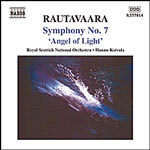
Symphony No.7, Angel of Light / Angels and Visitations
 $25.00
Low Stock
add to cart
$25.00
Low Stock
add to cart
RAUTAVAARA
Symphony No.7, Angel of Light / Angels and Visitations
Royal Scottish National Orchestra / Hannu Koivula (conductor)
[ Naxos / CD ]
Release Date: Sunday 16 March 2003
Should this item be out of stock at the time of your order, we would expect to be able to supply it to you within 2 - 5 business days.
Einojuhani Rautavaara was born in Helsinki on 9th October, 1928. Graduating from Helsinki University in 1952, he studied at the Sibelius Academy with Aarre Merikanto until 1955, and, after receiving a Koussevitzky Foundation fellowship in 1955, in New York at the Juilliard School with Persichetti, and then with Aaron Copland and Roger Sessions at Tanglewood.
He continued with important further study in Ascona with Wladimir Vogel, and with Rudolf Petzold in Cologne. A lecturer at the Sibelius Academy from 1966 to 1971, he was appointed to the state position of professor in arts in 1971.
Rautavaara's early compositions, typified by the prize-winning A Requiem in Our Time (1953), draw on the Nordic classicism derived from Sibelius and Nielsen, as well as the influences of Bartók, Shostakovich and folk-music. Among the first Finnish composers to make use of serial thinking, in such works as the Fourth Symphony (1963), Rautavaara widened his stylistic range widened appreciably during the 1960s. 1972 saw the completion of two of his most enduring works: Vigilia, drawing on Orthodox liturgical chant, and Cantus Articus (Naxos 8.554147), which employs taped birdsong alongside modal and aleatoric (chance-derived) elements. Tonality began to surface noticeably in his music of the 1980s, in addition to the waves and masses of sound as typified by the Fifth Symphony (1985). His operas Thomas (1985) and Vincent (1987) helped consolidate Finland's reputation as a centre for contemporary opera, while the growing popularity of his music can be gauged from the number of recordings and international commissions received over the last decade.
Composed in 1994, the Seventh Symphony, subtitled Angel of Light, was commissioned by the Bloomington Symphony Orchestra and first performed in Bloomington, Indiana, on the occasion of the orchestra's 25th anniversary in 1995. The composer is clear that the reference to angels should not be construed in a pictorial or programmatic way; rather it functions as an archetype in the mythical or spiritual sense, radiating, in this instance, a purely musical energy. The first movement, Tranquillo, opens with a hazy string background, glockenspiel and vibraphone chiming chromatically-inflected motifs, before an elegiac melody emerges on violins and violas. Brass and woodwind cap the main climax, then solo wind pensively elaborate aspects of the theme as the music pursues its unhurried course. Flute and harp add a dash of animation, and the full orchestra emerges briefly before the movement returns to its opening mood, now coloured by a modal warmth. The scherzo, Molto allegro, strikes in with a breezily ironic idea on wind and xylophone, to which the violins' expressive arching melody is a pointed contrast. Although the initial capriciousness returns, the main climax is thrice curtailed, with fragments of the ironic music left adrift over a pedal point in the lower strings. This leads directly into Come un sogno (Like a dream), the expressive heart of the work. Violins intone a chorale-like melody, woodwind and horn responding in a warmly pastoral discourse. After the briefest of climaxes, a solo violin continues the chorale theme over gently undulating woodwind and lower strings, the movement turning almost imperceptibly to the minor at the close. The finale, Pesante, opens with a commanding brass fanfare, then strings lead off with another modal-sounding melody, decorated by lively woodwind arabesques. These become increasingly florid, before the music quietens and upper strings continue the theme in more austere textures. The main climax is reached with full brass and tam-tam, after which the work does not so much end as vanish, quickly and mysteriously, out of earshot.
Composed in 1978, Angels and Visitations is the first work in Rautavaara's 'Angel Series', followed by the Double Bass Concerto, 'Angel of Dusk' (1980), the Fifth Symphony (1985) and later by the Seventh Symphony, and is among the first representative works of his maturity. The impetus came from reading Rainer Maria Rilke - "... should one suddenly press me to his heart, I would perish by his more powerful presence ..." - and from revelations experienced through dreams during childhood. Again, no programme should be read into the work, which the composer has likened to continuous variations on the theme of contrast or polarity, and on the differences concealed in all things. The work begins with distantly swarming strings, touched off by harp and untuned percussion. Brass and tuned percussion enter as the music grows more menacing, then gentle woodwind figures usher in an expressive theme for strings. This grows fuller in scoring, before ascending to the upper reaches of the violins. The swarming motion suddenly appears threateningly in the depths, and the music erupts in strident brass and rushing strings, capped by a dissonant brass chorale. Scurrying wind heighten the tension, and tolling bells add their presence, before the main theme gradually re-emerges to steer the work into calmer waters. Nevertheless a sense of unease remains palpable, as the music returns to the mood of its opening, with baleful brass effecting a last outburst, as if to underline the momentousness of what has been experienced.
- Richard Whitehouse
Tracks:
Symphony No.7, "Angel of Light"
01. Tranquillo 11:28
02. Molto allegro 5:52
03. Come un sogno 9:18
04. Pesante 8:35
Angels and Visitations
05. Angels and Visitations 20:49
